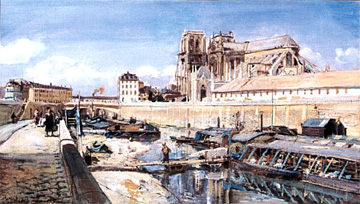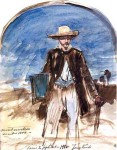
Johan Barthold Jongkind
Dutch, 1819-1891 (active France)
The Cathedral of Notre-Dame as seen from the Pont de l’Archevêché, 1849
oil on canvas
13 3/4 x 23 7/8 in.
SBMA, Museum purchase with funds provided by 19th-century Acquisition Fund
1999.1

Portrait of the artist by himself 1850 (annotated in 1860) Graphite (20,5x17 cm) Musée d'Orsay, Paris
"I miss my friends in Paris. Holland is fine to paint, but Paris is the only place to follow one's studies. One can find judges there who will encourage you, who wil tell one what is necessary and what is missing. My great hope is to return as soon as the weather and luck are on my side for he journey." - Johan Jongkind, letter from The Netherlands to Martin Beugniet in Paris, Oct. 1856
RESEARCH PAPER
Description of Painting
The painting is a light-filled view of the back of Notre-Dame from the Archevêche Bridge across the Seine. Painted in 1849, three years after Jongkind came to Paris from Holland, it anticipates the impressionist style of painting with its bright colors, short, heavy brushstrokes of white (which form clouds in the sky and highlights on walls), along with sketchily drawn figures of people. It is known that Jongkind’s working method was to paint the finished canvas in the studio using a number of watercolor and ink studies created at the scene.
An arch bridge downstream from the artist, connecting the left bank with the Ile de la Cite’, serves as the focal point of the composition. Strong diagonals lead to the arch of the bridge, along with a vertical pole at the left-center of the painting and a smoke plume just above the horizon, which points directly downward to the bridge. Rectilinear shapes of buildings, boats, and walls along the river dominate the scene, with the great bulk of Notre-Dame looming over the buildings near the edge of the river. A counterpoint to the geometry of the walls is the s-shape of the left river bank.
The strong blue colors in the sky (the artist was noted for the color of his skies—"Jongkind Blue"—developed as the result of training in Holland) are broken by white clouds and bright earth tones in the masonry walls. Strong sunlight is denoted by the use of shadows and contrasting value in both the stone and stucco walls. Thick brushstrokes of white show highlights on vertical walls, while the texture of cobblestones is created by dark, single brushstrokes in the walkway to the left side of the picture. Reflections of anchored boats and the walls of the cathedral are rendered in detail through the use of bright colors against the blue-green water. The few figures that appear in the painting are drawn in a simplified fashion; their colors somewhat muted.
Significance of the Work
Johan Jongkind can be called a precursor to Impressionism. His handling of light and color in his paintings certainly anticipated the Impressionist style a quarter of a century before the famous Impressionist show of 1874. Not only did he greatly influence the young Claude Monet, but also, because his paintings were seen and (to an extent) collected by several other artists in Paris in the 1860’s, his influence extended widely in the circle of artists that later became the Impressionists. Camille Pissarro said of him "If he had not been, we had not been" , and Eugene Boudin said that it was Jongkind who opened the door through which he and all the Impressionists entered . Thus, it is apparent that Jongkind’s influence was both widespread and greatly appreciated.
This work in the Santa Barbara Museum of Art collection is a very early representation of a French urban scene. French landscape painters in the first half of the nineteenth century had concentrated on depicting "natural" landscape (sometimes with allegorical themes), emphasizing feeling and imagination, as exemplified by the Barbizon school. This painting represents an early example of the recognition of the urbanization that was taking place in France in the mid-nineteenth century. With other paintings in the SBMA collection that are currently displayed in the Ridley-Tree Gallery: View of the Trocadero (1872) by Berthe Morrisot and Pont St. Michel (1905) by Henri Matisse, the visitor can see a sequence showing the dramatic change in the depiction of the French urban landscape over a period of half a century.
The Artist
Johan Jongkind was trained in both Holland and Paris. His early training was in the Dutch landscape tradition and then, at age 27, a grant from the Dutch government allowed him to travel to Paris for continued education. Studying under the French marine painter Eugene Isabey, Jongkind began to develop a style that emphasized the play of light and atmosphere well before the Impressionist movement was formally recognized. He lived and worked primarily in France for the rest of his life.
Several of his paintings were accepted at the Salons during the 1848-1855 time period, resulting in sales to the State and a medal in 1852. He later exhibited in the Salon des Refusés in 1863.
During visits to the Normandy coast, he met and befriended the painter Eugene Boudin in 1862, and through him, Claude Monet, who was 21 years his junior. Monet looked upon Jongkind as an experienced mentor, saying " I owe the critical training of my eye to him"
Jongkind lived in several locations in France, travelling widely; his friends included a wide circle of artists and dealers. Although his paintings sold, thus assuring him of a steady, if modest, income, he led a very simple lifestyle living with a "housekeeper", a Madame Fessier. An alcoholic, given to fits of depression, he worked sporadically and dissipated much of his income on alcohol. Following a stroke in 1891, he died in a hospital near Grenoble.
Bibliography
SBMA Sources
Hefting, Victorine, Jongkind, undated monograph: Curator File-SBMA, Detailed discussion of the artist’s life and work.
Bakker-Hefting, Victorine, J.B. Jongkind, undated, Meulenhoff, Amsterdam: SBMA Library, Book on the life and work of the artist—less detailed than reference 1, but with several illustrations of his paintings.
Exhibition Catalog, Johann-Barthold Jongkind, Carroll Carstairs Galleries, 1939: SBMA Library, Essays on the significance of Jongkind’s work, from a catalog of a 1939 exhibition at Carroll Carstairs Galleries, New York.
Letter, Robert Henning to Cathy Pollack, Featured Work: 2 Paintings by Jongkind, January 12, 1999: Curator File-SBMA, Short discussion of the significance of Jongkind and the relationship of the paintings to the SBMA collection.
Cunningham, Charles C., Jongkind and the Pre-Impressionists, 1976: Curator File-SBMA, Monograph in a catalog of a 1976 exhibition at Smith College, Northampton, Massacheutts
General References
Janson and Janson, History of Art, New York, Abrams, 1979; Pp. 682-686, Discussion of the French Romantic landscape tradition.
Internet Sources
www.britannica.com, Jongkind, Johann Barthold, Thumbnail biography of the artist.
www.nationalgallery.org.uk, "The Boulevard de Port-Royal, Paris", 1877, Image of one of Jongkind’s later paintings…useful to compare to Boudin’s Abbeville Church…,1894 in the same gallery.
www.nga.gov, "Cart on the Beach at Etreat", 1862, Image of one of Jongkind’s beach scenes… useful to compare with Boudin’s paintings of beach scenes.
Prepared for the Santa Barbara Museum of Art Docent Council by:
Cliff Hauenstein/ March, 2001
GUIDE BY CELL
Guide by Cell Script
By Tracey Miller
• Welcome to ‘The Cathedral of Notre Dame de Paris, Seen from the Pont de l’Archeveche’’, an oil on canvas from 1849 by the Dutch artist Johan Barthold Jongkind. My name is Tracey Miller and I am a museum docent.
• Jongkind was born in The Netherlands and trained at The Hague. He received a royal stipend in the mid 1800’s which allowed him to move to Paris where he remained for the rest of his life.
• The painting is perhaps especially striking in today’s world as Notre Dame is once again without its spire! This is the 2nd time Notre Dame has lost its spire - the original, which was constructed in the 13th century and held up to over 5 centuries of wind & weather - was finally removed in 1786. During the 19th-century restoration of Notre Dame, the spire was recreated with a new version of oak covered with lead. It is this spire that burned in 2019.
• Johan Jongkind can be called a precursor to Impressionism as it was widely regarded that he was one of the artists who “opened the door” with his style that emphasized the play of light & atmosphere which became the hallmark of Impressionism. He was a mentor to the young Claude Monet who said “I owe the critical training of my eye to him.”
• Notice the incredible color of the sky – this blue was perfected by Jongkind during his training in the Netherlands and actually became known as ‘Jongkind Blue’.
• Jongkind positions us so we are looking at the view of Notre Dame as though we were simply strolling along the Pont de L’Archeveche’ (which translates to the Archbishops Bridge) and simply paused to take in the magnificent view ahead of us.
• His use of bright colors, the short, heavy brushstrokes of white (both in the clouds as well as on the walls) and the sketchily painted figures of the people bustling about their daily business, he has managed to capture the vibrancy of life along the Seine in a compelling way. Our eye is, of course, drawn to the magnificence of Notre Dame. But through the careful balancing of the vertical lines of the buttresses of the Cathedral and roof supports of the river barge, he is able to offset the huge amount of horizontal lines within our view, drawing our eye to focus on the top right of the painting.
SBMA CURATORIAL LABELS
Monet acknowledged the Dutch artist Jongkind as the source of inspiration for his own art. Indeed, Jongkind anticipated the Impressionists by some thirty years in his commitment to sketching outdoors and his abiding interest in treating landscape motifs serially at different times of day. Like Van Gogh, Jongkind’s earliest role models were the 17th-century Dutch landscape masters (Aelbert Cuyp, Jacob van Ruisdael, Meindert Hobbema). And like Van Gogh, study in Paris would send Jongkind irrevocably in the direction of progressive painting, despite critical incomprehension at the lack of finish that characterized his freely brushed landscapes.
In this painting, we see many things that would have delighted Van Gogh. Although the picturesque outline of the cathedral of Notre Dame is conspicuous, the focus is on working-class Parisians occupied with their everyday lives—in this case the washerwomen of the floating barges, toting their fresh bundles of laundry. The loose brushwork, high-keyed palette, and overall luminosity of the scene, observed from life, is precisely the kind of painting that brother Theo exhorted Vincent to emulate.
- Through Vincent's Eyes, 2022
